
Bryophytes are a group of land plants, sometimes treated as a taxonomic division, that contains three groups of non-vascular land plants (embryophytes): the liverworts, hornworts, and mosses. In the strict sense, Bryophyta consists of the mosses only. Bryophytes are characteristically limited in size and prefer moist habitats although they can survive in drier environments. The bryophytes consist of about 20,000 plant species. Bryophytes produce enclosed reproductive structures, but they do not produce flowers or seeds. They reproduce sexually by spores and asexually by fragmentation or the production of gemmae. Though bryophytes were considered a paraphyletic group in recent years, almost all of the most recent phylogenetic evidence supports the monophyly of this group, as originally classified by Wilhelm Schimper in 1879. The term bryophyte comes from Ancient Greek βρύον (brúon) 'tree moss, liverwort', and φυτόν (phutón) 'plant'.

The Marchantiophyta are a division of non-vascular land plants commonly referred to as hepatics or liverworts. Like mosses and hornworts, they have a gametophyte-dominant life cycle, in which cells of the plant carry only a single set of genetic information.
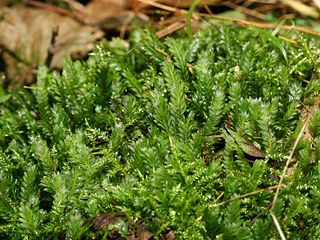
Fissidens adianthoides, the maidenhair pocketmoss, is a moss in the family Fissidentaceae. It was first collected by Hedwig in 1801.
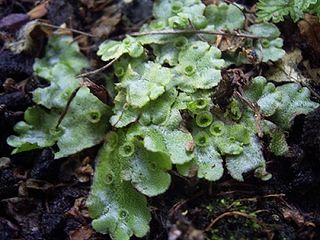
Marchantia is a genus of liverworts in the family Marchantiaceae and the order Marchantiales.
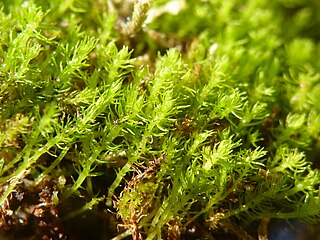
Takakia is a genus of two species of mosses known from western North America and central and eastern Asia. The genus is placed as a separate family, order and class among the mosses. It has had a history of uncertain placement, but the discovery of sporophytes clearly of the moss-type firmly supports placement with the mosses.
Monoicy is a sexual system in haploid plants where both sperm and eggs are produced on the same gametophyte, in contrast with dioicy, where each gametophyte produces only sperm or eggs but never both. Both monoicous and dioicous gametophytes produce gametes in gametangia by mitosis rather than meiosis, so that sperm and eggs are genetically identical with their parent gametophyte.

The Funariidae are a widespread group of mosses in class Bryopsida. The majority of species belong to the genera Funaria and Physcomitrium.

Takakia ceratophylla is one of the two species of toothless mosses in the genus Takakia, under the Takakiaceae family. This species was first described by William Mitten in 1861. Takakia ceratophylla is vulnerable and threatened by habitat loss due to human activities.

Tetraphidaceae is a family of mosses. It includes only the two genera Tetraphis and Tetrodontium, each with two species. The defining feature of the family is the 4-toothed peristome.

Marchantia polymorpha is a species of large thalloid liverwort in the class Marchantiopsida. M. polymorpha is highly variable in appearance and contains several subspecies. This species is dioicous, having separate male and female plants. M. polymorpha has a wide distribution and is found worldwide. Common names include common liverwort or umbrella liverwort.

Itatiella ulei is a species of moss in the family Polytrichaceae. It is the only species in the genus Itatiella. The Polytrichaceae is a common family of mosses that does not have close living relatives. Its small size and the inflexed leaf apex characterize Itatiella ulei. When this species grows directly exposed to sun at high elevations, it presents a similar aspect but can be distinguished based on the distal lamella cells which are single and rhombic.
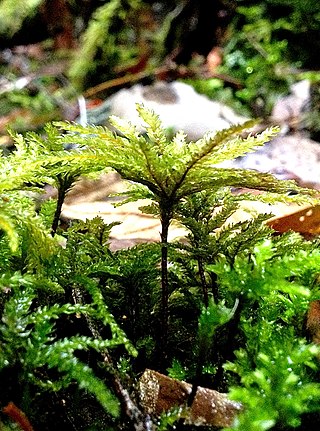
Hypnodendron comosum, commonly known as palm moss or palm tree moss, is a ground moss which can be divided into two varieties: Hypnodendron comosum var. comosum and Hypnodendron comosum var. sieberi. Both Hypnodendron varieties most commonly grow in damp locations in the temperate and tropical rainforests of New South Wales, Victoria, and Tasmania in southern Australia and in New Zealand.

Pogonatum urnigerum is a species of moss in the family Polytrichaceae, commonly called urn haircap. The name comes from "urna" meaning "urn" and "gerere" meaning "to bear" which is believed to be a reference made towards the plant's wide-mouthed capsule. It can be found on gravelly banks or similar habitats and can be identified by the blue tinge to the overall green colour. The stem of this moss is wine red and it has rhizoids that keep the moss anchored to substrates. It is an acrocarpous moss that grows vertically with an archegonium borne at the top of each fertilized female gametophyte shoot which develops an erect sporophyte.

Climacium dendroides, also known as tree climacium moss, belongs in the order Hypnales and family Climaciaceae, in class Bryopsida and subclass Bryidae. It is identified as a "tree moss" due to its distinctive morphological features, and has four species identified across the Northern Hemisphere. The species name "dendroides" describes the tree-like morphology of the plant, and its genus name came from the structure of the perforations of peristome teeth. This plant was identified by Weber and Mohr in 1804. They often have stems that are around 2-10 cm tall and growing in the form of patches, looking like small palm-trees. They have yellow-green branches at the tip of stems. The leaves are around 2.5-3 mm long, with rounder stem leaves and pointier branch leaves. Their sporophytes are only abundant in late winter and early spring, and appears as a red-brown shoot with long stalk and cylindrical capsules.
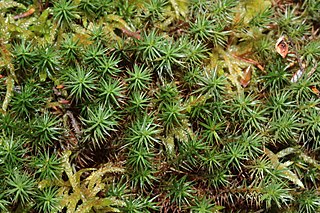
Polytrichum strictum, commonly known as bog haircap moss or strict haircap, is an evergreen and perennial species of moss native to Sphagnum bogs and other moist habitats in temperate climates. It has a circumboreal distribution, and is also found in South America and Antarctica.

Buxbaumia viridis, also known as the green shield-moss, is a rare bryophyte found sporadically throughout the northern hemisphere. The gametophyte of this moss is not macroscopically visible; the large, distinct sporophyte of B. viridis is the only identifying structure of this moss. This moss can be found singularly or in small groups on decaying wood, mostly in humid, sub-alpine to alpine Picea abies, Abies alba, or mixed tree forests. This moss is rare and conservation efforts are being made in most countries B. viridis is found in.

Tortula muralis, commonly known as wall-screw moss, is a species of moss in the family Pottiaceae. T. muralis is found throughout the world.

Syntrichia latifolia, formerly Tortula latifolia, and commonly known as water screw-moss, is a species of moss belonging to the family Pottiaceae. Syntrichia species differ from members of Tortula due to synapomorphic leaf qualities, such as different basal and distal cells, as well as different costal cross sections where Tortula has an abaxial epidermis and Syntrichia lacks one.

Polytrichastrum formosum, commonly known as the bank haircap moss, is a species of moss belonging to the family Polytrichaceae.
Andreaea blyttii, also commonly known as Blytt's rock moss, is a moss belonging to the family Andreaeaceae, commonly known as rock moss, granite moss, or lantern moss because of this family's unique sporangium. It is part of the genus Andreaea which is known for forming dark brownish or reddish-black carpets in high elevations. This species was first described by Schimper in 1855.


















